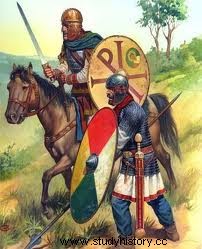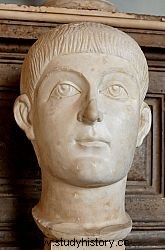We do not know exactly what year Frigiterno was born , whose original name in Goth, Frithugarnis , means “Wishing Peace ”. Leader of the Thervingi, his name appears in history when he petitioned the emperor Valens that his people might settle on the Roman side of the Danube. The question is obvious, Why wasn't Frigiterus content to remain in Dacia, in the hands of the Goths since it was ceded to him by Emperor Aurelian many years before? The answer had slanted eyes, he was small in stature and handled the bow very well on horseback. The Huns They massacred the Ostrogoths in 376 (Ost Goths , Western Goths), continuing their path of pillage and destruction towards the Eastern Roman Empire. The few survivors alerted the Visigoths (Wiss Goths , Eastern Goths) of the danger they faced and Frigiterno, his leader at the time, clearly saw the advisability of crossing the Danube as foederati Empire. At that time the Caesar of the East was Flavio Julio Valente , who had already successfully confronted the Goths between 367 and 369, threatening them in western Scythia (now Moravia and Wallachia). Valente agreed to the proposal of Frigiterno, who was an Arian like himself; For the emperor, a strategic alliance with the Visigoths would be a good retaining wall against the common danger that the Huns could represent. The Visigoths were settled in Moesia, at that time a poor and uninhabited province, granting them Roman citizenship in exchange for their military service and the consequent payment of imperial taxes. Not all barbarians crossed the river. Athanaric , Frigiterno's tribal adversary, remained in Dacia to his fate, perhaps because he was still a pagan and opposed the Visigoth leader's "Phil-Roman" policy.

Equite and legionnaire of Valente
Frigiterno's problems did not come from his internal disagreements. The Church and the more conservative aristocracy were soon opposed to the imperial decision. In turn, the excessive greed of the local administration ended up stirring up the new allies. According to the latest studies – perhaps less propagandistic and apocalyptic than the stories of Marcelino or Orosio , both contemporary Roman historians of these events – the number of barbarians who settled in Moesia would be close to 75,000, with only about 15,000 men of fighting age. To these should be added the nearly 4,000 Ostrogothic and Alan horsemen who escaped from the Huns and who joined the Visigoth contingent.
The situation in 377 became untenable. To the bad harvests was added the excessive greed of the comes (count) of Moesia, Lucipino , who became rich by inflating the prices of the supplies that the imperial administration intended for his foederati. It is also known that that year the pagan Atanarico crossed the river to join his countrymen, stirring up the Church that he saw in him the skin of the devil. Frigiterno, alerted to the plot that Lucipino had hatched to assassinate him, killed him during a banquet in which he planned to eliminate him.
Having broken ties with the Empire, and with his people demanding sustenance from him, Frigiterus headed for Thrace, pillaging cities and countryside to obtain the supplies his people needed to survive. Two small Roman armies were wiped out without much trouble, thereby alarming the Constantinople court. Vale reacted quickly. He left Antioch (Syria) where he was engaged with the Persians, to reach the Balkans at the head of a considerable army, seven legions, about 21,000 men, plus an even larger number of auxiliaries. He raised his camp next to a city that would go down in history for what had to happen in front of it: Adrianople (today Edirne, in European Turkey)

Adrianople
Valente, supported by his legacies Víctor and Ricimero (a hooligan rising to magister militum later), he formed before the Visigothic camp an imposing force. His seven legions had the elite troops, the legion palatinae , as well as a small force of cavalry also remarkable. There was only one difference with other previous clashes in the area of great magnitude, such as those that occurred during the Dacian war of Trajan. The legions of the fourth century had as such the name. The legionnaire of the year 378 had nothing to do with that of Marcus Aurelius or Trajan. With a long spatha instead of gladius, a scutum round instead of the classic square and chain mail instead of the lorica segmentata , was a less disposed, disciplined and equipped army corps.
On the other hand, the Goths had received Roman instruction as foederati, which they were, in addition to using all kinds of contact or thrown weapons, gaining forcefulness without suffering from the structural rigidity of the Roman lines. But its main advantage was not that mobility, but the weight of the cavalry in the strategy.
On August 9, 378, Valens led his troops out of the Adrianapolis camp, leaving his baggage and war treasure there, and formed up on a nearby plain before Frigiterno. The co-regent of the West, his nephew Graciano , had been diligent and came to the aid of his uncle, but he thought that he could not wait, perhaps spurred on by his legacy Sebastián or for other reasons that are unknown. I will not extend myself with the detailed account of this impressive battle, I will focus on the consequences of it. Winging , the commander of the Gothic cavalry, shattered the weak Roman cavalry, then harassed the legions on the flanks while Frigiterus pushed Valens's troops through the center until the battle turned to slaughter. Two-thirds of the Roman army never left the Adrianople plain, including Emperor Valens. According to contemporary testimonies, it was difficult to advance among so much blood, feces, urine and mutilated bodies. Given the bloodiness of the battle, where entire sections of the Roman line died killing given the evidence of not having a possible escape, it is logical to think that the Gothic casualties would also be considerable.
The end of Valens is controversial, as he left us Amiano Marcelino in the Stories of him , two things could have happened:
"He was mortally wounded by an arrow, and expired", (XXXI.12)
Valente was wounded and taken to a small wooden hut. The hut was surrounded by the Goths who set it on fire, not knowing who was inside (XXXI.13.14-6)

Vale
The truth is that the emperor's body was not recovered, so he was treated like any other legionnaire. Victor and Ricimero they led the survivors to Adrianople, perhaps in search of walls that would serve as a check on the Gothic tide. The entire European part of the Eastern Empire was left at the mercy of Phrygiterus, shocked and without his Caesar, who thoroughly plundered fields and cities with the exception of Athens, the besieged Adrianapolis, and the capital, Constantinople, because of the absence of machines. siege with which to bring down the walls of these great fortified cities.
Frigiternal he died as absolute king of the Visigoths in 380. he was succeeded by his old adversary, Athanaric . He could only reign one year, but before his death in 381 he got the new regent of the East, a legate of Hispanic origin called Theodosius , granted them the irrevocable condition of foederati of the Empire. Adrianapolis was the tomb of the legions. Ever since that immortal disaster, Theodosius favored the figure of the dux (duke) commanding a border army, limitanei , which would be supported by a free border army, comitatense , to go where the problems arose. Feudalism had just been born.
Twentieth installment of “Archienemies of Rome “. Collaboration of Gabriel Castelló.
